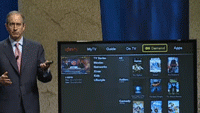Cloud computing overshadows Cable Show

Cloud computing and virtual storage were all the rage at The Cable Show last week in Chicago. This is due to the fact that traditional set-top boxes are clearly not capable of keeping up with the new Internet-based content services and social media sites that continue to emerge. The goal for cable operators is to retain customers by providing them with new, interactive capabilities to customize their TV viewing experience and interact with their peers online in real time — from a variety of screens. A virtual signal-processing environment makes the deployment of such services cost-effective and practical.
Confirming that interest was high this year, a large number of technical and business-related sessions — with titles like “Hey You, Get Onto My Cloud” — were well attended throughout the weeklong annual conference.
Among technology vendors, ActiveVideo Networks has developed new capabilities for its cloud-based app platform, called CloudTV, which helps cable operators offer subscribers the ability to watch video on demand (VOD) titles on one screen and then seamlessly move to another within a predetermined access window.
Among the many cable operator announcements related to cloud computing, Brian L. Roberts, chairman and CEO of Comcast, demonstrated his company’s new interactive TV service during a general session presentation. It will be the heart of the company’s nationwide Xfinity bundled service once trials are complete. The prototype interactive service, code named “XCalibur,” has been in trials in Augusta, GA, for the past year and could be deployed nationwide as soon as the end of the year. That’s one of the benefits of deploying a cloud-based content management architecture.
It includes support for the plethora of new Internet-connected consumer electronic devices (tablets, laptops, phones, etc.), allowing subscribers to begin watching a program on television and then move to a computer or more portable device without missing a beat. It will also manage every VOD transaction, Internet access session, television channel, and even phone calls.
The new Xfinity TV interface also offers customization tools, advanced search capabilities and social apps from a variety of partners (Pandora and Facebook, initially), all resulting in “a faster, more personalized cable TV experience,” Roberts said.
“It’s not just what’s available on linear TV but also what’s on demand and who’s online,” he said. “This is about bringing infinite choices and personalization capability to customers. Adding cloud computing, not storage, to the mix allows [operators] to have faster integration to take all of brains of the program guide and pull it out of the cable box.”
The professional video industry's #1 source for news, trends and product and tech information. Sign up below.
To deliver this bold endeavor, Comcast is using a set-top box made by Pace that includes Intel system on chip (SoC) technology inside. The board structure delivers the CPU and graphics performance required to power the new user interface and interactive applications available with the Xfinity TV service.
There are also features that “recommend” content based on what your Facebook friends are watching and a “MyTV” app that highlights the shows you were recently watching, along with other user-definable preference settings.
Intel said the SoC set-top box will enable Comcast to deliver services that are easier to navigate and search, as well as interactive applications that are seamlessly integrated into the television experience.
Sam Schwartz, president, Comcast converged products, said that thanks to putting the processing intensive work in the cloud, Xfinity TV can bring a much richer, personalized and interactive experience to viewers, and Comcast gets the ability to continually improve and expand features as business models evolve.
Indeed, with cloud computing, new features and services can be changed in the cloud once, and the changes take place immediately for Comcast customers across the country. This saves significant money and time and solves the cable operators’ dilemma of recurring set-top box obsolescence.
Operators buffeted by remotely located technology (e.g., “the cloud”), can also theoretically offer much faster broadband speeds. During his Xfinity presentation, Roberts announced that from its exhibit booth at The Cable Show, Comcast was able to download 23 episodes of NBC’s “30 Rock” in an astounding 99 seconds. This was reportedly sent over Comcast’s 11 miles of hybrid fiber-coax network in Chicago at an incoming date transfer rate of more than one gigabit (or one billion bits) per second.
